




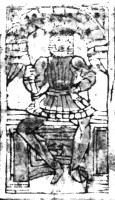
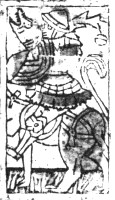









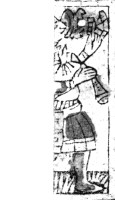

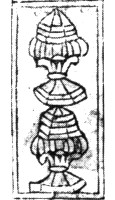
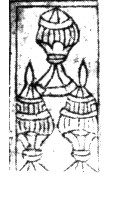





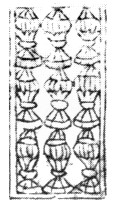

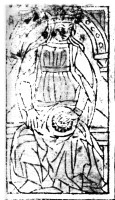










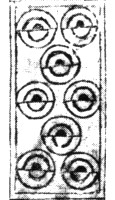


| ● | The card is more or less completely extant |
|---|---|
| ◕ | Most of the card is extant |
| ◑ | Approximately half of the card is extant (orientation shows which half) |
| ◔ | Less than half of the card is extant |
| ○ | The card is not extant, but would belong in this block |
| Card ↓ | Deck → | Tarot | Elegant | Fournier | Reversed | Crude | |||||||||||
|---|---|---|---|---|---|---|---|---|---|---|---|---|---|---|---|---|---|
| Block → | T1 | T2 | T3 | T4 | E1 | E2 | E3 | F1 | F2 | F3 | M1 | M2 | M3 | C1 | C2 | C3 | |
| Swords | Queen | ● | |||||||||||||||
| King | ◑ | ◔ | ● | ● | ● | ||||||||||||
| Knight | ● | ● | ● | ● | ● | ||||||||||||
| Knave | ● | ◕ | ● | ● | ● | ||||||||||||
| Ace | ● | ● | ● | ● | ● | ||||||||||||
| 2 | ● | ○ | ◒ | ○ | ● | ||||||||||||
| 3 | ● | ○ | ● | ○ | ● | ||||||||||||
| 4 | ● | ○ | ● | ○ | ◕ | ||||||||||||
| 5 | ● | ○ | ● | ○ | ● | ||||||||||||
| 6 | ● | ○ | ◕ | ○ | ● | ||||||||||||
| 7 | ◓ | ○ | ◕ | ○ | ● | ||||||||||||
| 8 | ◓ | ○ | ◕ | ○ | ● | ||||||||||||
| 9 | ◓ | ○ | ◕ | ○ | ● | ||||||||||||
| 10 | ◓ | ○ | ○ | ○ | ● | ||||||||||||
| Batons | Queen | ● | |||||||||||||||
| King | ● | ◔ | ● | ● | ● | ||||||||||||
| Knight | ● | ● | ● | ● | ◕ | ||||||||||||
| Knave | ● | ● | ● | ● | ● | ||||||||||||
| Ace | ● | ● | ● | ● | ● | ||||||||||||
| 2 | ● | ○ | ● | ● | ● | ||||||||||||
| 3 | ● | ○ | ● | ● | ● | ||||||||||||
| 4 | ● | ○ | ● | ● | ● | ||||||||||||
| 5 | ● | ○ | ◕ | ● | ● | ||||||||||||
| 6 | ◒ | ○ | ◕ | ● | ● | ||||||||||||
| 7 | ● | ○ | ◕ | ● | ● | ||||||||||||
| 8 | ● | ○ | ● | ● | ● | ||||||||||||
| 9 | ● | ○ | ● | ● | ● | ||||||||||||
| 10 | ● | ○ | ○ | ○ | ● | ||||||||||||
| Cups | Queen | ● | |||||||||||||||
| King | ● | ◔ | ● | ● | ● | ||||||||||||
| Knight | ● | ◔ | ● | ● | ◕ | ||||||||||||
| Knave | ◑ | ◑ | ● | ● | ● | ||||||||||||
| Ace | ○ | ● | ● | ● | ● | ||||||||||||
| 2 | ○ | ◑ | ○ | ○ | ● | ||||||||||||
| 3 | ○ | ● | ○ | ○ | ◕ | ||||||||||||
| 4 | ○ | ● | ● | ○ | ◕ | ||||||||||||
| 5 | ○ | ● | ● | ○ | ● | ||||||||||||
| 6 | ○ | ◕ | ● | ○ | ● | ||||||||||||
| 7 | ○ | ● | ◕ | ○ | ◕ | ||||||||||||
| 8 | ○ | ● | ◔ | ○ | ● | ||||||||||||
| 9 | ○ | ◕ | ○ | ○ | ● | ||||||||||||
| 10 | ○ | ○ | ○ | ○ | ● |
||||||||||||
| Coins | Queen | ● | |||||||||||||||
| King | ● | ◔ | ● | ● | ● | ||||||||||||
| Knight | ● | ● | ● | ◕ | ● | ||||||||||||
| Knave | ● | ● | ● | ● | ● | ||||||||||||
| Ace | ○ | ◕ | ● | ● | ● | ||||||||||||
| 2 | ○ | ○ | ◔ | ○ | ● | ||||||||||||
| 3 | ○ | ○ | ● | ○ | ● | ||||||||||||
| 4 | ○ | ○ | ● | ○ | ◓ | ||||||||||||
| 5 | ○ | ○ | ◒ | ○ | ● | ||||||||||||
| 6 | ○ | ○ | ◓ | ○ | ● | ||||||||||||
| 7 | ○ | ○ | ◓ | ○ | ● | ||||||||||||
| 8 | ○ | ○ | ◕ | ○ | ● | ||||||||||||
| 9 | ○ | ○ | ○ | ○ | ● | ||||||||||||
| 10 | ○ | ○ | ○ | ○ | ● |
||||||||||||
| Mato | ● | ||||||||||||||||
| Bagatella | I | ● | |||||||||||||||
| Imperatrice | II | ● | |||||||||||||||
| Papessa | III | ● | |||||||||||||||
| Imperator | IIII | ◕ | |||||||||||||||
| Papa | V | ● | |||||||||||||||
| Temperantia | VI | ◓ | |||||||||||||||
| Carro | VII | ◑ | |||||||||||||||
| Amore | VIII | ◓ | |||||||||||||||
| Fortezza | VIIII | ◕ | |||||||||||||||
| Ruota | X | ● | |||||||||||||||
| Tempo | XI | ● | |||||||||||||||
| Traditore | XII | ● | |||||||||||||||
| Morte | XIII | ● | |||||||||||||||
| Diavolo | XIIII | ● | |||||||||||||||
| Fuoco | XV | ● | |||||||||||||||
| Stella | XVI | ◓ | |||||||||||||||
| Luna | XVII | ● | |||||||||||||||
| Sole | XVIII | ● | |||||||||||||||
| Angelo | XVIIII | ● | |||||||||||||||
| Iusticia | XX | ● | |||||||||||||||
| Mondo | ● | ||||||||||||||||
Kings: With the exception of deck A, all kings are seated on a throne underneath a stone arch. The tarot kings have a different style of arch from the rest, otherwise the style is similar across the decks. In deck A where only the tops of the cards are preserved, there is no arch, but the size of the heads in relation to the knaves suggests that they must be seated. A very narrow strip remaining of the right edge of one of the cards supports this assumption.
Deck C swords and cups are inferior mirror-image copies of the Fournier cards, the remaining two are in a very similar style, but the coins' pose is more similar to the tarot. Deck B is even cruder. Here a queen takes the place of a king, but has the same rank unlike in tarot decks.
Knights: Here the variation is much greater. Most decks have mounts seen from the sides, and the heads of both rider and mount is sometimes in profile but more often turned towards the viewer. In the Fournier cards and to a lesser degree deck A the mounts are seen diagonally so that they appear shorter, and there is more room for their heads. Only the tarots have the normal grassy ground underneath. In deck A it is more elaborate, in B and C there are various other surfaces, and in the otherwise elaborate Fournier cards, the mounts seem to be floating in the air.
In the tarot, the mounts in cups and batons have monstrous heads. The suit sign is atypical in the batons, and appears twice in the coins. The tarot and deck C have identical knights of batons. Decks B and C have identical knights of coins and swords, possibly also of cups (hard to tell because B's well preseved images show no clear suit symbols for cups and batons, while C's certain knicht of cups is very unclear). In the former the orientation is the same, in the latter ones deck B has mirror images as with most other cards. In coins and batons, the mounts are giant birds, possibly ostriches. The suit symbol in the batons is unusual. Deck B's presumed knight of batons has a human-headed mount, the body might possibly be that of a tiger. The card has no suit symbol, while in deck C the preservation is not good enough to determine if this is present or not. This card is atypical in that the rider faces away from the viewer.
Knaves: The knaves are merely standing on the ground, holding their respective suit symbol. The ground is depicted as in the knights, except that three of the Fournier knaves have a simple line suggesting the horizon.
Deck C cups is a copy of the tarot card. The tarot coins and deck B cups are female but have no other similarities. Beyond a similar pose in coins, decks B and C which have three knights in common are no closer to each other than to the other decks. Like in the tarot knight of coins, the suit symbol appears twice in the Fournier knave of coins; in deck A it appears thrice.
Aces: The non-tarot decks all have aces in a style similar to Tarot de Marseille and North Italian playing cards. Deck B have three slightly inferior reversed copies of the Fournier cards, but a slightly different design for the ace of coins. Deck C has simplified and partly reversed versions of the designs of Deck B. Deck A has entirely different designs in the same general style. The ace of swords from this deck is very similar to that in Tarot de Marseille, and would with the crown around the blade nicely complement the numeral cards of the tarot deck.
However, the two extant tarot aces have entirely unrelated designs, of which I know no close parallels. The ace of swords depicts a lion sitting on a grassy surface holding a curved scimitar, similar to that in decks B, C and Fournier, while the baton is held by a leopard. As the suit symbols of the two lacking aces are less suitable for holding than a sword or a baton, it is unclear if or how they would be held, as well as which animals they appeared with.
The same general idea is also found in the Tarot de Paris aces, where heraldic animals hold banners with the suit symbols.
Numerals: Some decks have direct copies of the same design, while others have similar designs in the same general style. Numerals of each suit is described separately below.
Swords: These are fairly well preserved in the tarot, the Fournier deck and deck C. The Fournier cards are copies of the tarot design, only with the edges slightly trimmed in order to fit on the narrower cards. Deck C has a cruder design, differing chiefly in that the swords in the former two pass through an elaborate crown, while in the latter one they are instead tied together by a strip of textile.
The layout of these cards in the main feature separating the Italian, Portuguese and Spanish playing card styles. These decks do not correspond to either of those, but might be seen as intermediate between the first two.
Batons: These are very well preserved in the tarot, the Fournier deck, deck B and deck C. The Fournier cards are here not copies of the tarot cards, but have a slightly cruder design. Deck B has mirror-image copies of the Fournier cards, while deck C again has a yet cruder design.
The shape of the batons is that used in Italian style cards, differing from those found in Portuguese and Spanish ones.
All cards have their value spelled out in letters on a central banner (even this text is mirrored in deck B). See below for a more detailed analysis of these legends.
Cups: These are well preserved in decks A and C, and partially in the Fournier cards. The designs are all different, with the Fournier cards slightly cruder than deck A, and deck C markedly cruder that the others.
Coins: These are very well preserved in deck C and partially in the Fournier deck. Again, deck C has a markedly cruder design.
All preserved number cards above ace in the suit of batons have a banner across the center with the appropriate number spelled out with letters. For the most part, the numbers are written in their expected contemporary vernacular Italian forms. These are quite close to the names of the cards as recorded by Tomaso Garzoni in 1585, and to modern Italian.
However, for 2 and 3, classical Latin forms are used. Latin declined
the numbers up to three in grammatical cases, and for no obvious reason
the tarots, the Fournier and reversed
decks use the dative forms,
while the crude
deck has accusatives. The elegant
deck has
no surviving baton number cards. Garzoni uses the normal Italian forms
derived from the Latin nominatives. Another anacronism is settem
in the tarot. The final m was already weak in classical Latin,
and disappeared long before the assimilation of medial pt to
tt.
| Card | Tarot | Fournier | Reversed | Crude | Garzoni | Classical Latin |
|---|---|---|---|---|---|---|
| 2 | duobus | duob2 | duob2 | duos· | due | duo – duōs – duōbus |
| 3 | tribu9 | *****·* | *****·* | ·tres | tre | trēs – trēs – tribus |
| 4 | quatro | quatro | quatro | quatr· | quattro | quattuor |
| 5 | cinque | :cinq3 | :cinq3 | ·cinq3· | cinque | quinque |
| 6 | ]*o· | ]eo: | seo: | ·sei· | sei | sex |
| 7 | ·settem | sete[ | sete | * | sette | septem |
| 8 | ·otto· | otto | otto | oto | otto | octo |
| 9 | nuoue· | nove | nove | nou | noue | novem |
| 10 | ·diexe: | – | – | dexe | dieci | decem |
The symbols here approximated by '2' and '9' are variants of the abbreviation sign normally expanded us, even though in the latter case it is somewhat redundant given the preceding u. '3' approximates a sign which after q expands to ue. The asterisk represents approximately one unreadable letter, brackets indicate that the end of the inscription is not visible on any of the fragments.
Though the inscriptions on the threes in the Fournier and the
reversed
decks (mirror images of each other) are illegible, there
can be no doubt that they are botched copies of the text tribu9.
On the seven of the crude
deck, the ribbon on which the text
should be is folded so that it forms three segments. On the middle
segment there are two strokes that could possibly represent tt,
while the two outer ones are clearly empty in all fragments.